by Margaret Sgarra, contemporary art curator
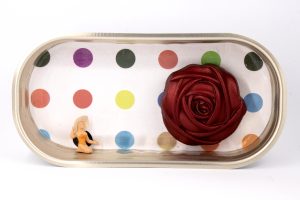
La Chigi, a multi-material artist born in Bassano Del Grappa, defines herself as “a creator of small worlds”. Her works focus on the individual struggling with existence, and with the relationships one develops during this time frame. The installations she created highlight the concept of utopian, dystopian, ordinary or extraordinary “history”. She took part in several collective and personal exhibitions, creating, among other things, participatory art projects. Currently she lives and works in Trento.
In your research, the use of very small characters who play different roles within society and deal with the critical issues of our time is recurrent. How did this interest in human beings and their stories arise?
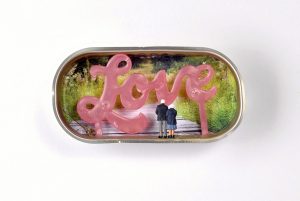
I have always loved stories, like those I find in books and images, or inventing them starting from our objects, the small ones that, due to their reduced size, we continually lose. I have always walked looking at the ground, searching for stories in lost objects, parts of other people’s lives and pieces of memory. It was a major physical trauma that made me understand my need for relationships and connections. Just as the need for stories and meetings with others gave me the push to seek, and find, a way to communicate with others and get to know them. During the pandemic the absence of people and the impression of mounting discomfort at a collective level led me first to imagine their stories, and then to materialize them into works, with the aim of creating a therapy against the darkness of fear in which we risked getting lost. In Contenitori di pesce I distilled surreal stories to materialize feelings and emotions in which we could be reflected and that would allow us to meet. Now the meetings continue, outside the boxes, also thanks to the boxes.
The Janas series stages different stories inside aluminum boxes. The stories are created by assembling different techniques and objets trouvés. How do you choose the materials for your works?
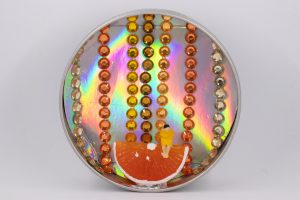
A work is always the fruit of a concept around which I mentally “materialize” the materials that I will have to use, therefore to research or to create from scratch. It’s a long process because I work by stratifying materials and meanings, starting from commonly used objects, preferably recycled ones and object trouvés, traces of us over time. For me, waste is an opportunity and an engine to produce art. I play with the “limits” of the objects, with their physical side and usefulness/use, and also with their the potential, subverting their use, letting myself be influenced by their shape, size and their color. Boxes are the objects I use the most. They are, like all containers, already “healthy” carriers of stories and, due to their small size, they force us to work first through reversal and re-signification, then through subtraction and synthesis. The empty box-container is already a condensation of my work that combines Dadaism, Surrealism and conceptual art, creating a space that is both intimate and collective.
Which work from this series do you feel most connected to and why?
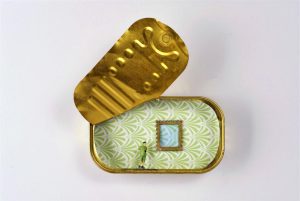
Difficult to choose. However, I would say the work Déjà-vu, also because I am in it. The work is a playful and surreal reflection on the value of art in our lives, on its necessity, above all for the ability it has to make us understand the world giving us the vision of it, ferrying us further with awareness. Déjà-vu because art speaks to us, about us and of what surrounds us. It is the work that reflects my relationship with art the most. An art made of amazement, of mutual reflections, new visions and perspectives. And, last but not least, the work with the gap, even semantic. The ironic cognitive dissonance on which it is based forces us to stop and get involved to solve the “puzzle” of reality.
Alice and the ordinary extraordinary is a series of works dedicated to Lewis Carroll’s Alice in Wonderland. What led you to create this tribute?
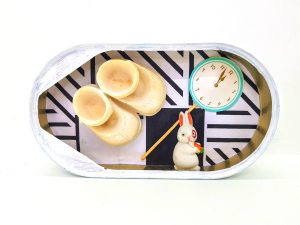
Alice in the Wonderland is one of my favorite novels. It’s a playful story full of nonsense, surreal and funny. It is also a metaphor for a certain approach to life, with childlike amazement and with wonder. There is an intimate poetry and a dream dimension in the reality that surrounds us. Too often we ignore it, busy chasing time. But literature helps us to discover it, educating us to observation and therefore imagination. Among our waste and in the objects that surround us, unexpected pockets of meaning are hidden, new stimuli, and a smile that perhaps will save us not only from the realism, even brutal, of everyday life, but also from the functionalism of objects, projecting us into new stories. We need to give a new meaning to things and reconnect with ourselves. Playing and storytelling are the way.
In your work there are projects in which there is the direct involvement of the individual in the creative process, as in the case of “Distanziamento”. Can you tell us how your participatory art projects develop?
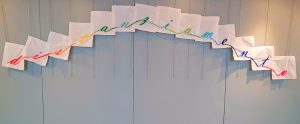
Relational art projects arise from the identification of a small marginalized community that needs adequate recognition. They are very long projects because I interact in codified situations, such as in prison, for example with the “(S)confinamenti” project, not yet concluded since 2020. Or in “critical” moments, for example during the pandemic, which we find in the project ” Distanziamento,” which took over a year. Therefore it is necessary to review the initial project over and over again over time to achieve the objective of creating a new social fabric, not only in metaphorical terms, through listening and involvement. In “Distanziamento” together with 14 ladies from a Senior Center in Trento we transformed the word into a huge collective rainbow (3.5m), thus overcoming the isolation and distancing imposed by the pandemic.
In your opinion, what function should art have in our society?
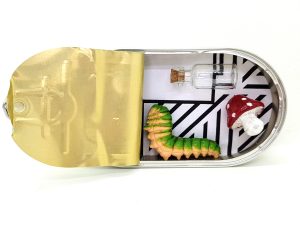
Art must be a tool of denunciation and activism. It must be contemporary, the fruit, but not a reflection, of us and our time. It is necessary, in fact, to problematize and not simply document the present, highlighting its contradictions to increase our awareness of what we are experiencing, perhaps changing perspective. Art must therefore “contain” uncomfortable references to domestic violence, ecologism, gender and relationships, as well as a reflection on the language with which we create worlds, bridges or barriers and prisons. At the same time art must give us a future. It must not flatten itself out on present distortions, but allow us to bathe in reality, and at the same time to give us anchors of dreams and freedom. To do this, in my opinion, irony and play are fundamental: they create an estrangement and a fertile dissonance capable of stimulating reflections.
Is there any artist who is a source of inspiration for you?
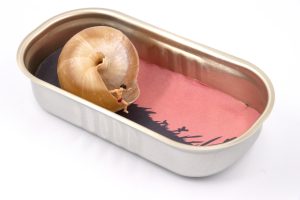
I am a compulsive devourer of art in 360-degrees. I absolutely love the work of Maurizio Cattelan and Marina Abramovich. The first for his caustic irony, and the second for her ability to enter into a profound relationship with the spectator. However, it is certainly in the art of the neo-avant-garde of the twentieth century that my work has its roots: Duchamp and the DADA movement for the idea of ready-mades first and foremost, but also surrealism and then conceptual art. In fact, I transform a box, preferably a fish one, into a small house/world, with objects that are often found, then I combine them with a surrealist principle, in order to create dreamlike scenarios through metaphorical and analogical associations. The conceptual aspect emerges in the titles that call the viewer into question and in the very process of transforming the space of the box and containers into interior houses.